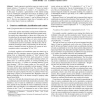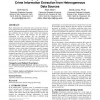1791 search results - page 352 / 359 » Two Types of Multiple-Conclusion Systems |
CIKM
2008
Springer
13 years 8 months ago
2008
Springer
Most prior work on information extraction has focused on extracting information from text in digital documents. However, often, the most important information being reported in an...
ECAI
2006
Springer
13 years 8 months ago
2006
Springer
Abstract. Searle represents constitutive norms as count-as conditionals, written as `X counts as Y in context C'. Grossi et al. study a class of these conditionals as `in cont...
DGO
2008
13 years 8 months ago
2008
Much information that could help solve and prevent crimes is never gathered because the reporting methods available to citizens and law enforcement personnel are not optimal. Dete...
EMNLP
2007
13 years 8 months ago
2007
In Sequential Viterbi Models, such as HMMs, MEMMs, and Linear Chain CRFs, the type of patterns over output sequences that can be learned by the model depend directly on the model‚...
SDM
2010
SIAM
13 years 8 months ago
2010
SIAM
We describe a novel semi-supervised method called WordCodebook Learning (WCL), and apply it to the task of bionamed entity recognition (bioNER). Typical bioNER systems can be seen...


